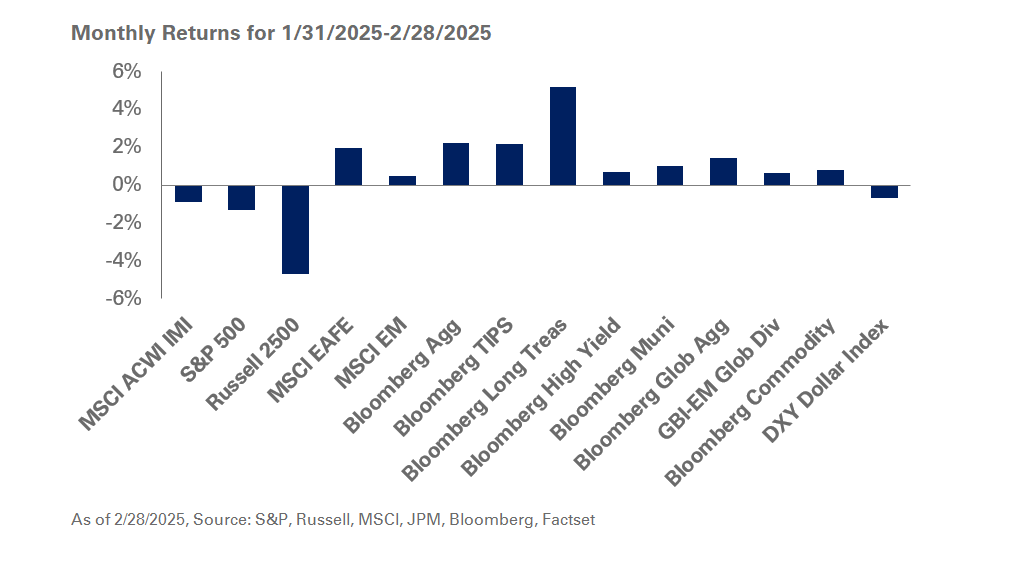Global Equities
Stocks ended the fourth quarter in the black, but the gains were overshadowed by the broader losses of 2022 as persistent and elevated inflation, slowing economic growth, and a hawkish stance from central banks underscored concerns around an economic slowdown. In the U.S., the S&P 500 Index gained 7.6% in the fourth quarter; in the same period, international equities outperformed with the MSCI EAFE Index up 17.3% and the MSCI ACWI ex U.S. Index returning 14.3% driven by better-than-expected earnings and a selloff in the U.S. dollar.
Meanwhile, private equity markets experienced lower valuations as the year pressed on. Fundraising totaled $285.9 billion in the fourth quarter, according to data from Preqin, compared to $386.3 billion a year earlier. For the year, fundraising totaled $1.3 trillion, modestly down from 2021, despite a significant drop in the second half of the year amid heightening economic concerns and limited partners (LPs) exhausting 2022 commitments earlier on in the year.
New deal activity declined in the fourth quarter and in 2022, while private equity and venture exits were also significantly lower. Private equity deal activity in the U.S. totaled $234 billion, according to PitchBook, down 36% from a year earlier. Similarly, deal value across venture capital, totaling $36 billion for the three months ended December 31, was down 36% from a year ago, according to data from PitchBook. Exit activity for U.S. private equity experienced a steeper slowdown in the fourth quarter, totally $54 billion, a 73% drop from a year earlier, according to PitchBook. Exit value for venture stood at $5 billion, 97% lower than a year ago.
Global Fixed Income
Doubling down on its commitment to rein in inflation even at the expense of economic growth, the Federal Reserve boosted the Fed Funds rate by 75 basis points in October and 50 basis points in December—its sixth and seventh rate hike in 2022—bringing the benchmark rate to 4.25% to 4.5%, the highest level in 15 years.
In 2022, the longstanding negative correlation between high-quality fixed income and stocks reversed. Credit declined alongside stocks, with losses of 13% for the BBG Aggregate Index. The hardest hit fixed-income sectors were long duration, with U.S. long Treasury down 29.3% for the year.
In high-yield corporate debt, leveraged loans were the best relative performer, falling a modest 0.6% in total returns for the year as floating-rate coupons offset rising rates. In contrast, high-yield bonds fell 11.2%. However, credit spreads have stayed below 500 basis points, with limited defaults, underscoring relatively benign market expectations for credit.
Real Assets
The fourth quarter was a mixed bag. The Bloomberg Commodity Index returned 2.2% for the three months ended December 31, cementing gains of 16.1% last year. Crude oil eked out a modest 0.3% return in the fourth quarter and gains of 6.4% in 2022, a year marked by upheaval unleashed by the Russia-Ukraine conflict and rising inflation. Gold prices rebounded in the fourth quarter, up 9.8%, ending the year flat at -0.3%.
Global natural resources rallied in the three months ended December 31, posting returns of 17.2%, to end the year in the black at 10.3%. In a reversal from 2021, the energy sub-index carried the global natural resources total return, finishing 2022 up 32.3%. The S&P Global Infrastructure Index rebounded with a 10.2% return for the quarter, eking out gains of 0.1% in 2022.
Meanwhile, in real estate, the FTSE NAREIT REIT Index rebounded moderately in the fourth quarter, returning 4.5%; still, the asset class ended in the red with losses of 25% in 2022 as rising interest rates drove down valuations. Within real estate investment trusts, the residential and self-storage segments lagged in the fourth quarter, while retail proved to be the strongest.
In private real estate, returns continued to moderate in the fourth quarter as rising interest rates pressured asset values; the NCREIF ODCE Index posted a 5% preliminary gross loss for the quarter, while finishing the year up 7.5%. Fundamentals remain healthy for most sectors, though uncertainty persists around the future demand for traditional office space.
Elsewhere, private infrastructure strategies—particularly communications infrastructure, renewable energy, and energy transition strategies—are still seeing increased interest from investors.



